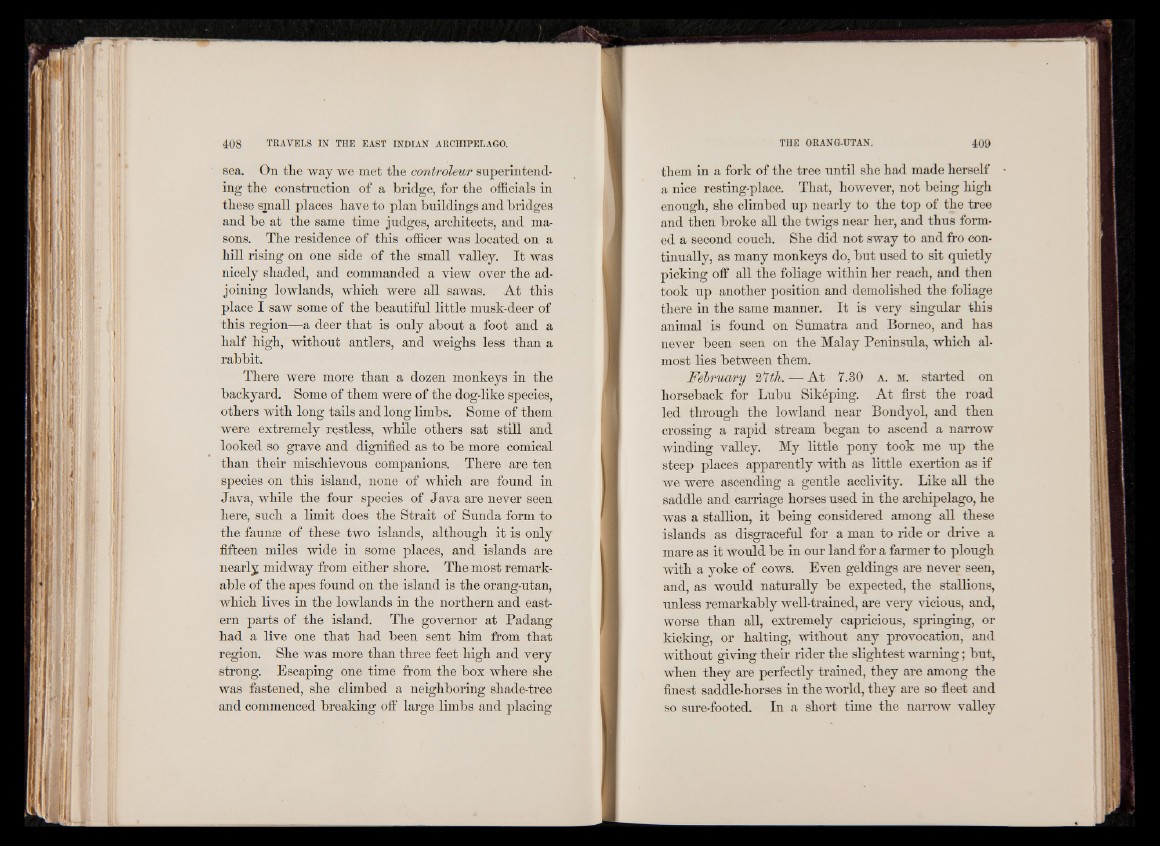
sea. On the way we met the controleur superintending
the construction of a bridge, for the officials in
these small places have to plan buildings and bridges
and be at the same time judges, architects, and masons.
The residence of this officer was located on a
hill rising on one side of the small valley. It was
nicely shaded, and commanded a view over the adjoining
lowlands, which were all sawas. At this
place I saw some of the beautiful little musk-deer of
this region—a deer that is only about a foot and a
half high, without antlers, and weighs less than a
rabbit.
There were more than a dozen monkeys in the
backyard. Some of them were of the dog-like species,
others with long tails and long limbs. Some of them
were extremely restless, while others sat still and
looked so grave and dignified as to be more comical
than their mischievous companions. There are ten
species on this island, none of which are found in
Java, while the four species of Java are never seen
here, such a limit does the Strait of Sunda form to
the faunse of these two islands, although it is only
fifteen miles wide in some places, and islands are
nearly midway from either shore. The most remarkable
of the apes found on the island is the orang-utan,
which lives in the lowlands in the northern and eastern
parts of the island. The governor at Padang
had a live one that had been sent him from that
region. She was more than three feet high and very
strong. Escaping one time from the box where she
was fastened, she climbed a neighboring shade-tree
and commenced breaking off large limbs and placing
them in a fork of the tree until she had made herself
a nice resting-place. That, however, not being high
enough, she climbed up nearly to the top of the tree
and then broke all the twigs near her, and thus formed
a second couch. She did not sway to and fro continually,
as many monkeys do, but used to sit quietly
picking off all the foliage within her reach, and then
took up another position and demolished the foliage
there in the same manner. It is very singular this
animal is found on Sumatra and Borneo, and has
never been seen on the Malay Peninsula, which almost
lies between them.
February Nth. — At 7.30 a . h . started on
horseback for Lubu Sikeping. At first the road
led through the lowland near Bondyol, and then
crossing a rapid stream began to ascend a narrow
winding valley. My little pony took me up the
steep places apparently with as little exertion as if
we were ascending a gentle acclivity. Like all the
saddle and carriage horses used in the archipelago, he
was a stallion, it being considered among all these
islands as disgraceful for a man to ride or drive a
mare as it would be in our land for a farmer to plough
with a yoke of cows. Even geldings are never seen,
and, as would naturally be expected, the stallions,
unless remarkably well-trained, are very vicious, and,
worse than all, extremely capricious, springing, or
kicking, or halting, without any provocation, and
without giving their rider the slightest warning; but,
when they are perfectly trained, they are among the
finest saddle-horses in the world, they are so fleet and
so sure-footed. In a short time the narrow valley